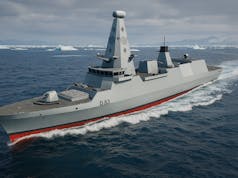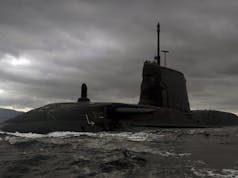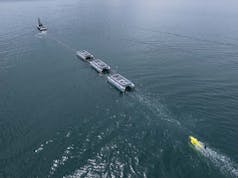According to a contract award notice, the Ministry of Defence intends to award a contract of up to five years (a three year initial term plus two option years) to Devonport Royal Dockyard Limited for “Contracting for Availability services for the Phalanx – Close In CIWS” from February 2023.
The notice states:
“The International Guns, Missiles and Rockets Project Team, part of the UK Ministry of Defence (MOD) intends to award a contract of up to five years (a three year initial term plus two option years) to Devonport Royal Dockyard Limited (DRDL) for Contracting for Availability services for the Phalanx – Close In Weapons Systems (CIWS) from February 2023 In accordance with regulation 4 of The Defence and Security Public Contracts (Amendment) (EU Exit) Regulations 2019 (SI 2019/697) this procurement falls to be regulated under the provisions of the Defence and Security Public Contracts Regulations 2011 as amended (in particular by SI 2019/697 and SI 2020/1450).
Prior publication of a contract notice in the Official Journal of the European Union is no longer appropriate. It is considered that the award of the contract without prior publication of a contract notice in the UK e-notification service is lawful under Regulation 16 (1) (a)(ii) of the Defence and Security Public Contracts Regulations 2011.
This is for technical reasons because only DRDL have the specific know-how, tools and means needed to meet the MOD’s In Service Support requirement concerning this complex military weapon system. In addition, DRDL are the sole licensed European operator of the Phalanx CIWS under a licensing agreement in place with Raytheon Missiles and Defence (RMD) who are the original equipment manufacturer.”
The Phalanx CIWS is a close-in weapon system for defending against anti-ship missiles. It was designed and manufactured by the General Dynamics Corporation, Pomona Division (now a part of Raytheon).
Consisting of a radar-guided 20 mm (0.79 in) Gatling gun mounted on a swivelling base, the Phalanx is used by multiple Navies around the world, namely the Royal Navy and the United States Navy on every class of surface combat ship, by the United States Coast Guard aboard its Hamilton-class and Legend-class cutters and the navies of 16 allied nations.













I’d love to know the breakdown of these maintenance contacts. I don’t believe this covers any upgrades so is it purely for ammunition, lubricants and a maintenance team. I know the rounds are expensive but what we are talking over £100 a piece?
Seeing the exercise in Poland today with the air defence system they have, could phalanx be mounted on a vehicle for short range defence or is this range not good enough?
You mean like at Camp Bastion?
It has been done.
Could be done if above Cab height with the appropriate Cams in place just watch out for Low bridges
No, on a vehicle to protect a deployed group from drones etc, i was just wondering if range and calibre wasnt high enough
I’m no expert but I would imagine that Phalanx is a lot of weight to have on top of a mobile vehicle… The Dutch have the Gepard mobile AA vehicle which might be along the lines of what you’re thinking?
Is that Goal keeper 30mm Chris
HI Tommo, I’m not sure if it’s related to Goalkeeper, I don’t think so, it’s German in Origin: https://en.wikipedia.org/wiki/Flakpanzer_Gepard
It looks like it’s slowly being phased out of service. The Dutch retired it in 2006.
Thanks Chris we had those Fitted instead of Phalanx on the Invincible EU knockoffs oops
Difference was goal keeper had to be cut into the ship in design but phalanx. Can just be surface mounted
And a slight price difference, Andy
How do prices compare?
Personally think phalanx is starting to look bit poor compared to some of other ciws
Updating systems future proofing Phalanx isn’t dead in the water yet so too speak Andy
Looks bit limited when compared to Chinese Russian or even Swiss offering
Just a thought , whether Russian and Chinese CIWs can work in conjuction with
other weapon systems on board their respective platforms at the same time or system overload ?
It’s not “limited” compared to what the Chinese or Russian have
1x 20mmcompared to 2x30mm and a short range missle system. I know that means nothing in capabilities but in hardware they win
Hi Andy/Tommo, South Korea is looking to update its CIWS platform with a new external design and tech.
https://www.janes.com/defence-news/news-detail/madex-2021-lig-nex1-hanwha-systems-showcase-competing-designs-for-rokns-ciws-ii-programme
When Ben Wallace was watching the exercise, i believe it was the PZA Loara system i saw, thats whats started me thinking
https://en.m.wikipedia.org/wiki/PZA_Loara
An AA tank (alright, SPAAG)? The Army looked at that with Chieftain Marksman. Didn’t go for it unlike the Germans with the Gepard.
As for whether Phalanx can be mobile, pretty sure the Yanks stuck a couple on HET trailers or the like in Afghanistan/Iraq.
Yes, it has been done and tested in the USA.
The US Army put an M61 cannon on an M113. It didn’t have the radar of the modern Phalanx, though.
It has been done actually, google “CIWS HEMTT”
Thank you, that does cool, but its obviously a lot heavier then i realised, for something more mobile.
I was living next to one in Basra!
https://pbs.twimg.com/media/Dnir-IkUwAAkSZE.jpg?format=jpg&name=orig
Can’t wait for Hornby / Airfix too make a scale model of that Mother
Centurion c ram it’s called, look at YouTube and u can see it shooting RPG down over bastion
Would the 40mm system being procured for the T31 offer a better CIWS option to replace Phalanx long-term?
Yes, with smart ammunition. It has a much longer range.
But can it react and shoot down like phalanx? Can it be put on auto point defence? Gunna be no use if needs human operator
This is an ageing debate with arguments; some half decent either way. The answer right now is no one has categorically proven it either way as there are pros and cons of each approach.
Is it in broad terms a case of the 40mm having a longer range and packing a bigger punch per round vs Phalanx which has the higher rate of fire and is cheaper to procure/operate?
Perhaps 3-4 40mm systems per destroyer or frigate would be better than the hodgepodge mix of 2-4 20mm Phalanx, 30mm & 40mm guns the Royal Navy is currently planning on?
To your last point, layering does work. To the first point, the last ditch second mm accurate performance of Phalanx can’t be reproduced by 40mm in a larger clumsier turret. 40mm must reply on the peppering effect of pre-detonating rounds in the missile’s flightpath. Phalanx just goes for tungsten direct hits. Both are effective but achieve their effect through very different mechanisms of action.
Depends on a lot of factors…. So just consider power supplies…
Phalanx is stand alone. It just needs seawater cooling and 440v for the mount to work
40mm will need a tracker be it radar or eo or both which will be seperate. So you will need power for a gun, power and services for the tracker and weapon alignment to consider.
Phalanx also does everything on mount. So it has its own surveillance radar, tracking radar, Threat evaluation computer, EO tracker , gun, cooling systems.
With a 40mm system you will need separate systems. So the ships own surveillance radar, command system, trackers, cooling , computers etc.
GB, I was under the impression the new 40mm Bae Sweden were working on a couple of years ago had a small tracking and ranging radar on top of the turret and only external sensor needed was for detection, still needs magazine through the deck to. Obviously bow to your departmental knowledge if I’ve read that wrong though. Personally Phalanx is a great bit of kit IMO, the plug and play nature of it gives so many uses. Shame no one continued development of the GAU-8 version after goalkeeper appeared.
Enjoy your sunshine haven’t seen it much recently.
I rained yesterday… RAINED.!!!. First time in 10-11 months for around 3 mins…i didn’t even have my ex Pussers foulie jacket available.
The Problem is that the dust and sand in the air also comes down so it rains mud in effect… Still the smell of wet concrete was nice, one of those smells I associate with the UK
👍
“The International Guns, Missiles and Rockets Project Team” as a non military outsider, that sounds like a fun team to work on… basically the ‘blowing shit up’ team!
Yeah i’d like that job.
The team just watches wide-screen video’s of things being blown up . Its the MOD version of Googlbox safely sitting no large Insurance coverage required
If Phalanx is to stand any chance against the latest anti ship missiles, it needs the 25mm upgrade that was proposed over a decade ago. This should not be down to RN, but an international combined upgrade.
It actually still fairs well against modern threats. Most anti ship missiles that are supersonic in the terminal phase aren’t maneuverable.
Well the 20×102 Phalanx round has muzzle energy of 60,500 joules. The 25×184 of the Oerlikon upgrade proposal (circa 2000), had a muzzle energy of 147,000 to 168,000 joules. The 25mm stands more chance. Though the trials for a new Korean 30mm CIWS gatling look interesting. One has an “all in one” configuration, like Phalanx, so it does not penetrate the deck. Bang up to date sensors on both the prototypes.
The energy isn’t really important, connecting with the incoming missile is. A 22LR will kill an elephant stone dead if it hits its frontal lobe or any other part of the brain. A 20mm will obliterate any incoming missil of it connects before it hitting the ship.
Energy is useful for range. A 20×102 is likely to engage so late that most of the missile (fragments) is/are likely to still hit the ship. You need to engage further out, so 25, 30 or 35mm is a better bet than 20mm.
If people want a vehicle mounted “drone” killer, then look no further than Rheinmetall’s latest offering !!!!
https://www.youtube.com/watch?v=pb5_F4_Eod8
Get rid of Phalanx and fit a modern CIWS like the Oerlikon Millennium Gun or the Thales RAPIDSeaGuardian, complemented by BAE Mk110 57mm guns that the Type 31s will be getting firing 3P, MAD-FIRES and ORKA ammo. That gives you a far better and far more flexible system to deal with a wide range of threats.
The Phalanx guns could be moved over to RFA ships and especially the Point-class ships that currently have no defences at all.
Phalanx is garbage. It lacks range and bullets are far less effective than airburst ammo. Buy a good effective CIWS like the Oerlikon Millennium Gun firing AHEAD ammo. Then complement it with the BAE Mk110 57mm gun firing 3P, MAD-FIRES and ORKA ammo.